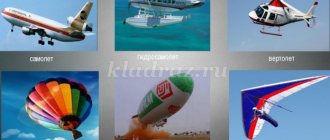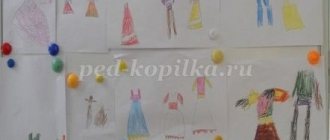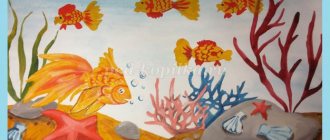Development of cognitive activity as a topic for self-education of kindergarten teachers
The teacher’s self-education work consists of two stages:
- Theoretical stage of self-education. First of all, it is necessary to study regulatory documents and scientific and methodological literature, which talk about the importance and methods of organizing the cognitive and research activities of preschoolers (Federal State Educational Standard and the educational programs developed within its framework). It is also important to study the practical experience of colleagues on the topic of interest: pedagogical journals and information portals on preschool pedagogy widely present materials on organizing experimental activities for children (carrying out projects in preschool settings, notes on individual classes and research-oriented outings). The theoretical stage also includes the development of thematic planning: setting general goals and objectives of the proposed course of study with a table of specific activities for each age group of students.
- The practical stage is the implementation of the prepared base into practice. The teacher organizes classes on research activities in accordance with the curriculum in the first half of the day or opens a circle for additional education. During the school year, the teacher holds thematic meetings or consultations for parents, in which he introduces them to the tasks of the experimental activity and shows the results achieved by the children. The teacher should strive to involve preschoolers in project activities and participation in city and regional competitions. The teacher reports on the effectiveness of his work at teacher councils, seminars and thematic round tables.
In the process of research work, children’s natural need for experimentation and curiosity is satisfied. Carrying out observations and participating in experiments brings joy and delight to the little researcher. At the same time, during these classes an important information base is laid about the properties of objects and substances and the thinking abilities necessary for success in the future are developed.
Lesson on cognitive and research activities in kindergarten
Cognitive and research activity is one of the spontaneous manifestations of a child’s curiosity. This quality of an inquisitive mind must be actively involved in a variety of classes: studying the surrounding world, productive (drawing, modeling, designing), preparing for literacy, etc. Exclusively research activities occupy a small part in the educational process, sometimes they are separated into club activities (work in mini-laboratories, experimental workshops). The teacher should practice conducting integrated classes in which work is carried out in several directions (“artistic and aesthetic development”, “cognitive activity”, “labor activity”, etc.), paying maximum attention to the formation and improvement of research skills when studying by children objects and phenomena of the surrounding world.
After directly studying the vegetables, the children can draw them
Table: card index of topics for educational and research activities
| Research topic | Tasks | Age group |
| "Water and its properties" |
| Junior |
| "Magic Sponges" |
| Junior |
| "Lemon" | Formation of the ability to conduct research in various ways: visual, olfactory, kinetic. | Junior |
| “I'm a researcher. Stone" |
| Junior |
| “Why did the snowman melt?” |
| Average |
| "Milk" |
| Average |
| "Lost and found" |
| Average |
| "Amazing Ball" | Formation of ideas about the properties of rubber in the process of research activities. | Average |
| "Merry vegetable garden" | Expanding knowledge about cultivated plants and methods of growing them. | Average |
| "Energy. Current runs through the wires" |
| Older |
| "The Amazing Magnet" |
| Older |
| "Pillow" | Development of the ability to compare, generalize and draw conclusions (using the example of studying pillows with various fillings - synthetic winterizer, cotton wool, fluff, buckwheat husk, straw). | Older |
| "Volcano" | Improving the ability to work with various materials and substances during the experiment. | Older |
| "Worms" |
| Older |
| "Salt" | Formation of ideas about the properties of salt (including salt water) and their use in production and everyday life. | Preparatory |
| "Thermometer" |
| Preparatory |
| "The Diver from Komarovo" | Formation of ideas about the floating of bodies, air pressure and liquids. | Preparatory |
| "Human Pupil" | Acquaintance with the properties of the pupil to expand and contract depending on lighting. | Preparatory |
Table: lesson notes on cognitive and research activities in the senior group (fragment)
| Author | Zakharova E., teacher of MBDOU D/s No. 8 “Cheburashka”, Belaya Kalitva, Rostov region. |
| Subject | "Volcano" |
| Target | Introduce children to a natural phenomenon - a volcano. |
| Tasks |
|
| Materials |
|
| Progress of the lesson | Motivation. V.: Guys, today the postman brought us a parcel. Are you interested in knowing what's in it? (They open it, there is pumice there). Who knows what this is? What is the name of? What is it for? Maybe someone has such an item at home? (Children's answers). Preschoolers examine pumice and compare it with the rocks already available in the experimentation corner: coal, chalk, sandstone. V.: There is also a note in the parcel, and there is a hint in it, listen:
But this object does not look like a volcano at all. This hint did not help us, but, on the contrary, confused us. Guys, are you interested in knowing what this item is? Then we will try to find out. We will also find out what a volcano is and how it is connected to the mystery object. The teacher tells the children a legend about the volcano. <,…>, V.: Now do you want to see what a real volcano looks like? (Children's answers). Our computer will help us. (Show slides with different types of volcanoes: “sleeping”, “waking up”, “boiling”, erupting). Volcanoes erupt in different ways. Sometimes they seem to explode, throwing magma up and to the sides. A huge mountain shakes with a terrible roar, a huge cloud of smoke and ash rises above it, and stone rain showers the slopes. And sometimes it flows out “calmly.” What does a volcano look like? (A volcano is a large mountain with steep sides). What shape is the volcano? (Cone). At the very top of the volcano there is a crater. The crater is a huge bowl with steep slopes, and at the bottom there is a reddish-orange mouth, this is the mouth of a volcano, a hole going deep into the ground. The fiery liquid coming out of a volcano is called lava. Interesting? Do you want to see a volcanic eruption? I suggest you do an experiment: a volcanic eruption. Where can you do experiments? (In the laboratory). I suggest you go to our laboratory of “interesting discoveries” (they go to tables with volcano models prepared in advance and all the necessary components for the experiment). In our laboratory, everything is ready to conduct experiments. What will we make the base of the volcano from? (From the cone). What is a volcano's mouth made of? (A plastic cup). All this is on a tray. Before you begin the experiment, you need to study the diagram. (The teacher, together with the children, discusses the sequence of the experiment.)
What are you observing? Watch your volcano erupt. It erupts calmly. <,…>, Guys, can we show a volcanic eruption? Shall we try? Sketch “The volcano wakes up and erupts.” V.: Guys, you and I did the “Volcanic Eruption” experiment, and I told you the legend about the volcano, and we learned the structure of the volcano, and even depicted the volcano ourselves... But they forgot a little about our mysterious object, what it is after all ? Maybe someone figured it out after all? (Children's answers). And if we don’t know something, who or where can we find out? (Encyclopedia, reference book, on the Internet). Do we have an encyclopedia in the library? Let's see if there is an answer to our question. We open it and read: this is pumice - frozen volcanic lava. Used to remove dirt from hands or rough skin from heels. Questions for reflection:
V.: I’m glad that you really liked it, and you were so attentive, active, inquisitive, great fellows! |
| Quote from: https://www.maam.ru/detskijsad/konspekt-zanjatija-poznavatelno-isledovatelskaja-dejatelnost-vulkan-starshaja-grupa.html | |
Lesson time plan
The duration of educational classes in kindergarten depends on the age of the students and is determined by SanPiN standards:
- junior group - 15 minutes,
- middle group - 20 minutes,
- senior group - 25 minutes,
- preparatory group - 30 minutes.
In the middle of the lesson, physical education or an active game should be carried out as a means of preventing overwork.
Since cognitive-research activities require mental effort, they should be conducted in the first half of the day, preferably on Tuesday or Wednesday - days of high performance.
Table: time plan for the lesson “Visiting the Paper Fairy” in the younger group
| Structural component of the lesson | Motivating start (surprise moment) | Didactic game | Physical education minute | Study of paper properties | Summarizing |
| Time spending | 2 minutes | 2–3 minutes | 1–2 minutes | 7 minutes | 1–2 minutes |
Table: time plan for the lesson “Journey to the World of Water” in the middle group
| Structural component of the lesson | Motivating start (creating a game situation, solving riddles) | Didactic game | Outdoor game | Studying the properties of water (conducting experiments) | Summarizing |
| Time spending | 2–3 minutes | 3 minutes | 3 minutes | 10 minutes | 1–2 minutes |
Table: time plan for a lesson during a walk “Why do icicles cry?” in the senior group
| Structural component of the lesson | Motivating beginning (reading and discussion of a didactic fairy tale) | Charging outdoors | Research (observation of icicles in the shade and in the sun) | Work assignments | Conducting an experiment with ice floes | Summarizing |
| Time spending | 3–4 minutes | 5 minutes | 10 minutes | 5–7 minutes | 4 minutes | 2 minutes |
Table: time plan for the lesson “What is a rainbow?” in the preparatory group
| Structural component of the lesson | Motivating beginning (surprise moment, problematic situation, watching a video) | Heuristic conversation | Outdoor game | Didactic game | Studying the conditions for the appearance of a rainbow (conducting an experiment) | Summarizing |
| Time spending | 3 minutes | 3–5 minutes | 3–4 minutes | 3 minutes | 12–14 minutes | 1–2 minutes |
The use of visual material when organizing experimental activities in preschool educational institutions
Within the framework of the designated topic, we are not talking about visual materials traditionally used in classes - posters, illustrations, cards with diagrams. Research activities are accompanied by a mandatory stage of work - documenting the information received. The teacher should draw the children's attention to the fact that scientists (researchers and inventors) write down their observations and conclusions that they come to in the process of studying any phenomena or properties of objects.
To record observations of preschoolers, the following forms can be used:
- Research cards. The children fill out special forms, which are then compiled into a file cabinet of observations and experiments.
- Personal diary of observations. This form offers more room for creativity and expression of individuality than cards. Children can be allowed to make notes, sketches, and diagrams in their diary.
- Stands. You can record children's experimentation by designing stands: hanging a plan for conducting experiments, diagrams and photographs with the results.
- Lapbooks are hand-made folding books on the topic of research carried out (“Water”, “Weather”, “Insects”, “Properties of Air”, etc.). Templates can be used to create such books. It will be great if parents help the children in designing lapbooks.
A laptop is a thematic folder containing a number of pockets, windows, and miniature nested books. It can accommodate a huge amount of material on the topic, presented in the form of cards, illustrations, diagrams, educational games, etc.
Photo gallery: visual materials for recording research activities in kindergarten
Research cards display observation results
The observation log displays the results of daily research
You can make a nature diary yourself or purchase it in a store.
Older preschoolers can keep individual observation diaries
The results of experiments can be recorded in special notebooks
The finished laptop can be studied for a long time and with interest.
Making a lapbook helps children explore an object comprehensively
Video: what is a lapbook
Analysis and diagnosis of cognitive and research activities
To evaluate the results and effectiveness of students’ cognitive and research activities, the teacher conducts diagnostics according to the following criteria:
- ability to formulate problems for students,
- correct formulation of questions,
- building an action algorithm to solve the problem,
- putting forward hypotheses,
- choice of research methods,
- ability to describe observations during the research process,
- presence of thinking skills (analysis, comparison, generalization, systematization),
- degree of independence at each stage of the research,
- ability to make inferences, conclusions, summing up.
A high level of cognitive and research activity is evidenced by the presence of stable motivation to solve problem situations and search for answers to posed questions, independent construction of a research algorithm and carrying out practical work (experiments), competent formulation of the information obtained, and correct drawing of conclusions. A child with a developed research type of thinking takes the initiative in choosing materials and tools for conducting observations, is not afraid to put forward hypotheses and test them experimentally, and brings what he starts to the end in order to obtain compliance with the voiced hypothesis or refute it.
Future researchers are not afraid to put forward hypotheses and test them experimentally
To identify the attitude of pupils towards experimental activities and determine the level of mastery of research skills, the teacher can invite children to keep a special journal in which preschoolers record the results of the work done. At the same time, it is recommended that the teacher keep diagnostic cards for each student, in which he enters data from his own observations of the children’s research activity.




